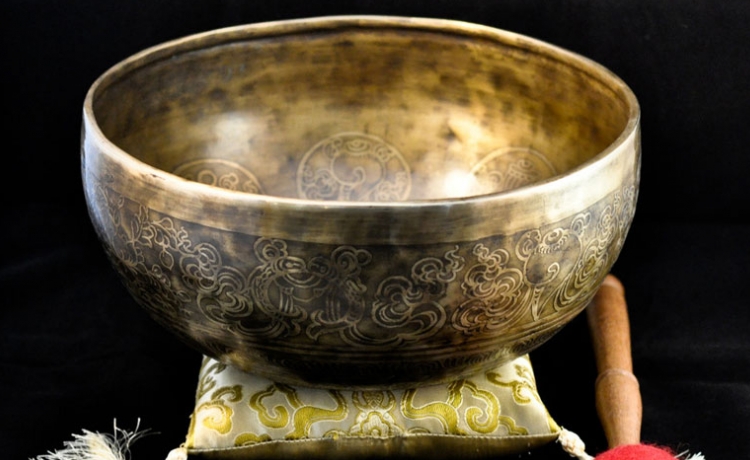Singing Bowl in Nepal

Published Date :10 Jan, 2016
Singing bowl is a treasure. The singing bowl is originated in the pre-Buddhist Bon culture of the Himalayas often called Tibetan singing bowls; they are actually made in Nepal, Bhutan, India and Tibet. The bowls are made of seven sacred metals. One metal for the each of the planets are: Gold-Sun, Silver-Moon, Mercury-Mercury, Copper- Venus, Iron-Mars, Tin-Jupiter, and Lead-Saturn. A handmade object can vibrate individual and simultaneous tones. Every metal manifests its individual sound and harmonics-each offering its own exceptional medicine of sound, relaxation with bowl. The singing bowl is an excellent tool for meditation, centering and trance induction. They are used by the healers to tone and balance the energy body field. The sound and the feeling of large singing bowl vibrating on ones chest or abdomen is transmitted via the skeletal system through the entire body.
Singing bowls can be used to make music. Body Therapists, Yoga Teacher, Music Therapists and Regular meditators have been exploring and working with these wonderful celestial sounds.
The effects of singing bowl on the body are:
1) Promotion of the energy balance
2) Reduction of stress and involved emotions
3) Reducing tensions of life forces
4) Balancing of hemisphere of the brain
5) Upgrading of creativeness and imagination
6) Helping harmonize body, spirit and soul
7) Giving a positive self-imagine and empowering assertiveness
Healing with sound and singing bowls:
Many singing bowl therapists perform aura or chakra treatments. The aura is the ethereal field that surrounds and penetrates objects, living beings, can be perceived by sensitive and clairvoyant people as a colored haze Our physical body and the subtle bodies of the aura are inextricably linked and are actually intermingled. A sensitive singing bowls therapist intuitively hear, see and feel whether there are any weak spots in the aura, then they find the correct tone from the singing bowl for the treatment.
The most important chakras are wheel shaped centers at the level of the endocrine glands, which form connections between the physical body and cosmic energy passing through the aura. So, singing bowls can be used for Seven Chakra healing.
There are two types of singing bowls found in the market: one machine made with plane and smooth surface; the other one is handmade and of more metals by the expert. We can see hammer beaten mark on the side. Once you gong it, it produces longer harmonious sound. Handmade singing bowls are mostly used for healing therapy, meditation, sound therapy, sound massage, space clearing, for finding music notes and feng shui now a days. Likewise there are other types of singing bowls found in the market like antique finishing handmade bowls, itching bowls, carving bowls, and gift set bowls. All the bowls are of different size and of different weight. Singing bowls are played rubbing the rim of the bowls by a wooden, plastic or leather wrapped mallet around, this produces vibration and overtones. High quality singing bowls produce a complex chord of harmonic overtones. The art of making singing bowls in the traditional way is often called a lost art, but traditional craftsmen do still make singing bowls in the traditional manner in hidden corners of Nepal but few contain sky-iron.
Antique singing bowls are a subset of the general class of household brass bowls that were used for cooking, eating, and storage in Nepal, Bhutan and Tibet. One reason for the popularity of brass as a material for these uses is for the anti-bacterial properties as well. It is estimated that millions of these bowls were made over the centuries. The small percentage among these millions of bowls has the tonal coherence that qualifies them as the Singing Bowl. Antique singing bowls may display abstract decorations like lines, rings and circles engraved into the surface. The decoration can be seen outside the rim, inside the bottom, around the top of the rim and sometimes on the outside bottom. Antique singing bowls are expensive and collected worldwide. They are popular due to their craftsmanship and remarkable sound. The aging process greatly improves the tone and produces incredibly rich sound. The new singing bowls either plain or decorative one feature religious iconography, spiritual motifs or symbols such as Tibetan chanting mantra “Om Mani Padme Hum”, Images of Buddha and Astamangala.
Related Blog(s)
- Experiencing Free Walking Tour Kathmandu with Shiva Dhakal
- Trekking en Poonhill
- Nagarkot to Changunarayan Hiking
- 5 must-see places in Kathmandu
- 5 tips for your first trek in Nepal
- Free Walking Tour Kathmandu
- Nagarkot Changunarayan Hiking
- Champa Devi Hiking
- Bandipur Village Tour
- Tips: before you trek to Nepal
- Langtang Trekking Review
- Poonhill Trekking Review
- Ghorepani Poonhill and Village Tour in Nepal
- Village Tour in Nepal : Gorkha
- Osho Tapoban Review - A Secluded Spiritual Getaway from Kathmandu
- Dakshinkali Pharping - A Local Experience!
- Pupal Yarsha Festival - 2016
- Lacs Gokyo et camps de base de l'everest avec Himkala Adventure
- Hiking in Nepal
- Rudraksha (Utrasum), Ammonite Fossil (Shaligram), Spatika (Quartz) in Nepal
- Thangka Painting in Nepal
- Pashmina in Nepal
- Gorkha-The Historical Place
- Shopping in Nepal with Himkala Adventure
- Trekking in Nepal with Himkala Adventure
- Garden of Dreams:The Garden of Six Seasons
- Pokhara: An Enchanting City
- Nepal: Beautiful Country in the World
- Bhaktapur: The City of Artistic Treasure
- World Tourism Day 2015




